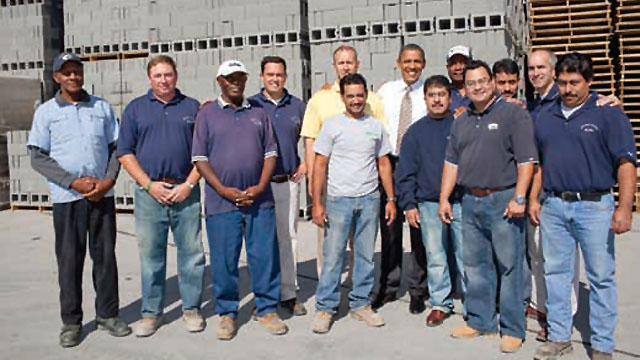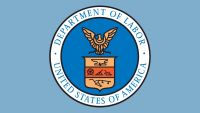February 7, 2011 7:00 AM CST
That story and the President’s words about “bricks and blocks” will be a guide to changing our industry for the better. How did this happen, given what you hear from the media or see every day in your business? It is a story about faith. It is a story about people. It is a story about resolve.
At age 23, in June 1995, I became the interim CEO of Ernest Maier. Ernest Maier had 3,000 8- X 8- X 16-inch block on the ground, no sales backlog and no money. I had to fix the company. The customers weren’t the hardest people to convince but, rather, the employees and the owners. No one believed I was competent, due to my age and lack of experience in “the business.” Making people believe in something for which they have no evidence is tough, especially when they are there every day seeing the lack of evidence.
After getting a $50,000 short-term loan from a bank, faith that was inspired by credit instilled faith in the most important person: me. Now, I had to lead. It meant shoveling material under cubers, cubing open bottom bond beams by hand, delivering block in a pickup, dispatching at 5:30 a.m., making deposits, cleaning up the general ledger, going on sales calls,writing every memo in Spanish and English, and getting to know each and every employee.
My example made them believe, and that belief saved the company. Faith had gotten us out of the hole. Now, we had to learn how to walk.
A block machine only runs well when the people who work with it make it
productive. Productivity, especially in the masonry trade, is a function reliant on the people more than the machine. The scaffolding may move people more quickly up and down or “swing” them around faster. The people will determine the profit more than the scaffolding.
What we did at Ernest Maier directly contradicted everything that the Maier family told me. “Don’t give them more money. We need to cut our coverage on the health insurance. We don’t do a retirement plan. We give turkeys for Christmas.”
I told them that we were going to pay 20 percent more than anyone else in the industry. We were going to cover 100 percent of each individual’s health insurance. We needed to start a retirement plan, which we did. We were giving cash at Christmas, rather than turkeys.
Investing in people meant increasing the expected return. Our return would exceed the industry average. Our people would perform tasks such as delivering material, collecting money and taking blame that other company’s employees would not have to do.
Paying people less and expecting less is a recipe for disaster. This industry has spent the last 15 years saying it does not matter how heavy a block is or how much you pay a bricklayer. You hear that the bricklayers are not like they used to be. Ignoring productivity and human capital investment translated into big profits ironically. Decreased productivity created “labor cost” inflation in estimates (e.g., laying less bricks per day or blocks per day created more bricklayer days). Estimating departments applied “overhead and profit” percentages to inflated labor costs. Those overhead and profit dollars exceeded all office expenses and allowed for big profits.
It means that we all have to look at our people daily and ask whether we are investing in them or in ourselves. If the objective of a business is to make “me” money, it almost certainly will have only limited, short-term success. That success must be shared, if it is to become long-term.
A mason contractor asked me in May 2008,“What should I do?”
I replied,“Buy a submarine.”
The analogy that I explained was that the market, due to Icarus and other factors, was going to get ugly. Fear and paranoia are destructive and deflationary forces. Shut it all down and raise the “periscope” every six months to see if the water is clear. If you see burning warships, go back under water and wait a little while longer.
I tell everyone that the hardest part about resolve is that we live in the short-term and believe in the long-term. Each day is a crisis, but those crises should be teaching points for me or my employees. I learn more about my company when we “lose” than when we “win.” Those losses should inform your decision making, amend weak parts of your plan, and strengthen your resolve to persevere through tough times.
It is a call to transform the marketing and promotion of our products and trade. It is a call to invest in educating our labor force and making it more productive. When people ask who we compete against, I always answer with “ourselves.” When we fix our house, we then need to go out and beat the crap out of our competition, whether it is tilt-up, glass, siding, precast panels or steel. The President wants us to do it.
President Obama and the Future of Masonry
The President describes our industry as the “bricks and blocks of our entire economy.”

The President visits with Ernest Maier employees.
On Oct. 8, 2010, President Barack Obama visited Bladensburg,Md.-based Ernest Maier Block Company Store to deliver a speech about the September employment report and the state of the economy. Most of the questions I have received regarding that visit center on my politics or the politics of the company. Those questions could not be further from the most important aspect of this visit: President Obama endorsed Ernest Maier’s story and our industry’s products, and he spoke about the story of fixing Ernest Maier.That story and the President’s words about “bricks and blocks” will be a guide to changing our industry for the better. How did this happen, given what you hear from the media or see every day in your business? It is a story about faith. It is a story about people. It is a story about resolve.
Faith
Everyone assumes that faith has to do with God only. Faith is a belief in something for which you have no empirical evidence.At age 23, in June 1995, I became the interim CEO of Ernest Maier. Ernest Maier had 3,000 8- X 8- X 16-inch block on the ground, no sales backlog and no money. I had to fix the company. The customers weren’t the hardest people to convince but, rather, the employees and the owners. No one believed I was competent, due to my age and lack of experience in “the business.” Making people believe in something for which they have no evidence is tough, especially when they are there every day seeing the lack of evidence.
After getting a $50,000 short-term loan from a bank, faith that was inspired by credit instilled faith in the most important person: me. Now, I had to lead. It meant shoveling material under cubers, cubing open bottom bond beams by hand, delivering block in a pickup, dispatching at 5:30 a.m., making deposits, cleaning up the general ledger, going on sales calls,writing every memo in Spanish and English, and getting to know each and every employee.
My example made them believe, and that belief saved the company. Faith had gotten us out of the hole. Now, we had to learn how to walk.
People
While faith carries you to a certain point, people carry you to the finish line. Investing in people always will yield more return than investing in a new block machine, new scaffolding or a new forklift. Those rely on the human element.A block machine only runs well when the people who work with it make it
productive. Productivity, especially in the masonry trade, is a function reliant on the people more than the machine. The scaffolding may move people more quickly up and down or “swing” them around faster. The people will determine the profit more than the scaffolding.
What we did at Ernest Maier directly contradicted everything that the Maier family told me. “Don’t give them more money. We need to cut our coverage on the health insurance. We don’t do a retirement plan. We give turkeys for Christmas.”
I told them that we were going to pay 20 percent more than anyone else in the industry. We were going to cover 100 percent of each individual’s health insurance. We needed to start a retirement plan, which we did. We were giving cash at Christmas, rather than turkeys.
Investing in people meant increasing the expected return. Our return would exceed the industry average. Our people would perform tasks such as delivering material, collecting money and taking blame that other company’s employees would not have to do.
Paying people less and expecting less is a recipe for disaster. This industry has spent the last 15 years saying it does not matter how heavy a block is or how much you pay a bricklayer. You hear that the bricklayers are not like they used to be. Ignoring productivity and human capital investment translated into big profits ironically. Decreased productivity created “labor cost” inflation in estimates (e.g., laying less bricks per day or blocks per day created more bricklayer days). Estimating departments applied “overhead and profit” percentages to inflated labor costs. Those overhead and profit dollars exceeded all office expenses and allowed for big profits.
It means that we all have to look at our people daily and ask whether we are investing in them or in ourselves. If the objective of a business is to make “me” money, it almost certainly will have only limited, short-term success. That success must be shared, if it is to become long-term.
Resolve
All that glitters is not gold. Our faith and our commitment to our people do not mean that business during the last two years has been easy. It has been even more difficult than saving the business. Everything is easier when you have nothing to lose.A mason contractor asked me in May 2008,“What should I do?”
I replied,“Buy a submarine.”
The analogy that I explained was that the market, due to Icarus and other factors, was going to get ugly. Fear and paranoia are destructive and deflationary forces. Shut it all down and raise the “periscope” every six months to see if the water is clear. If you see burning warships, go back under water and wait a little while longer.
I tell everyone that the hardest part about resolve is that we live in the short-term and believe in the long-term. Each day is a crisis, but those crises should be teaching points for me or my employees. I learn more about my company when we “lose” than when we “win.” Those losses should inform your decision making, amend weak parts of your plan, and strengthen your resolve to persevere through tough times.
Obama
As long as I can remember, no sitting President has ever visited a block plant and talked about our industry as the “bricks and blocks of our entire economy.” At a time when we are losing to glass curtain walls, tilt-up concrete construction, wood construction and steel-stud construction, President Obama highlighted our business. We must use this press and momentum to effect change in ourselves and in our trade. You fix things one block at a time. We must do the same.It is a call to transform the marketing and promotion of our products and trade. It is a call to invest in educating our labor force and making it more productive. When people ask who we compete against, I always answer with “ourselves.” When we fix our house, we then need to go out and beat the crap out of our competition, whether it is tilt-up, glass, siding, precast panels or steel. The President wants us to do it.
Originally published in Masonry magazine.
About the Author
Brendan Quinn is CEO of Bladensburg, Md.-based Ernest Maier Block Company Store. He can be reached at 301-927-8300 or bquinn03@emcoblock.com.


















